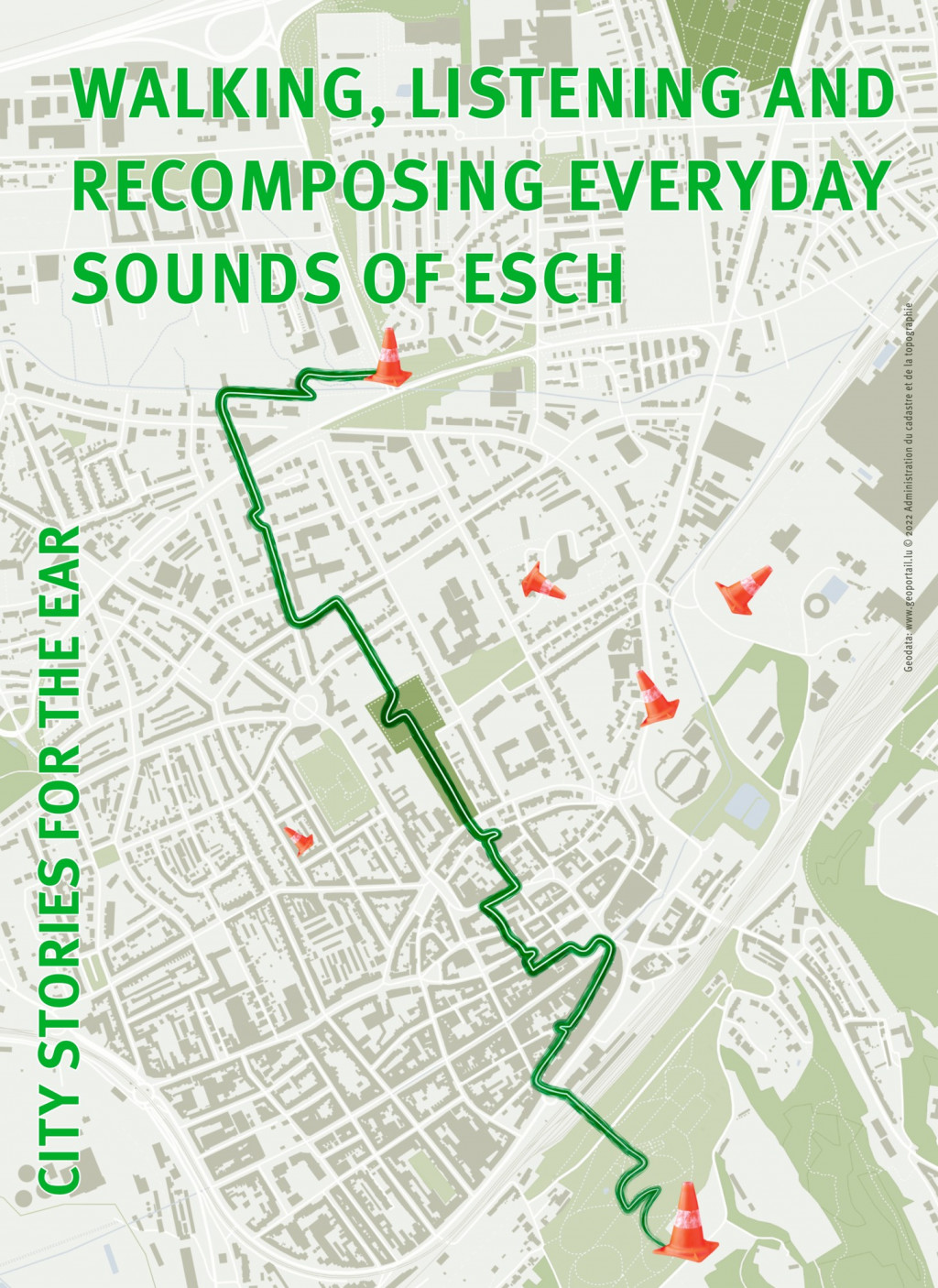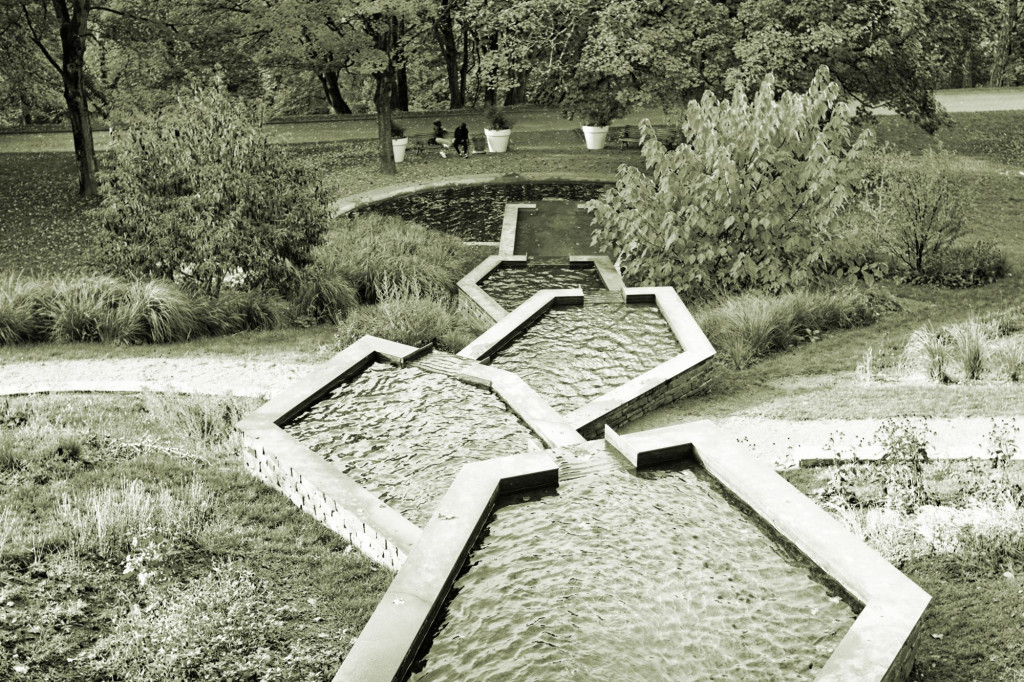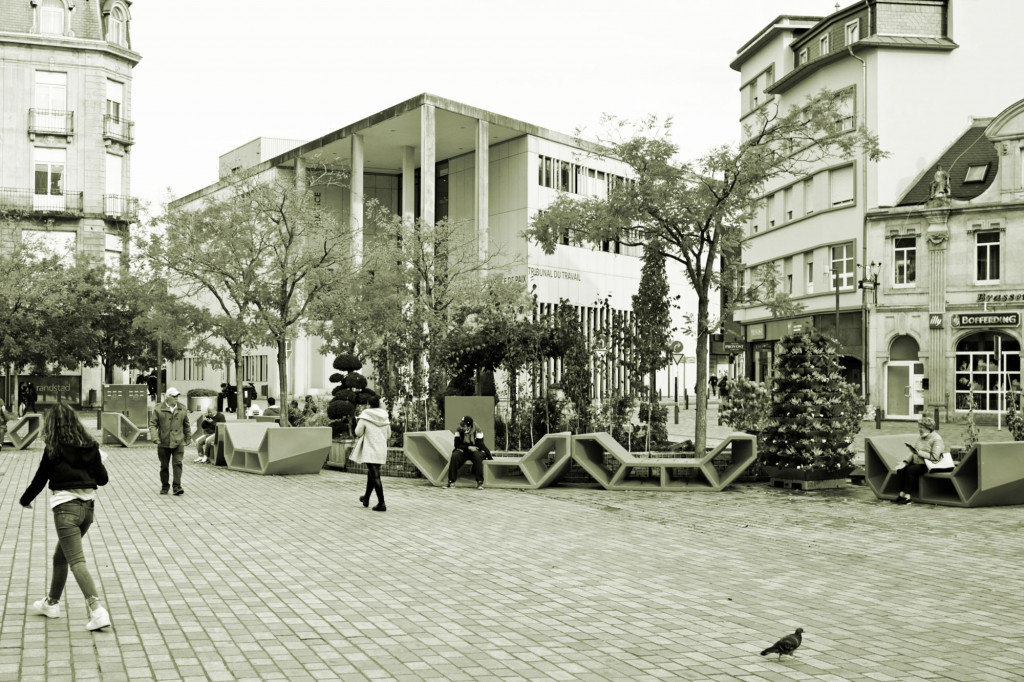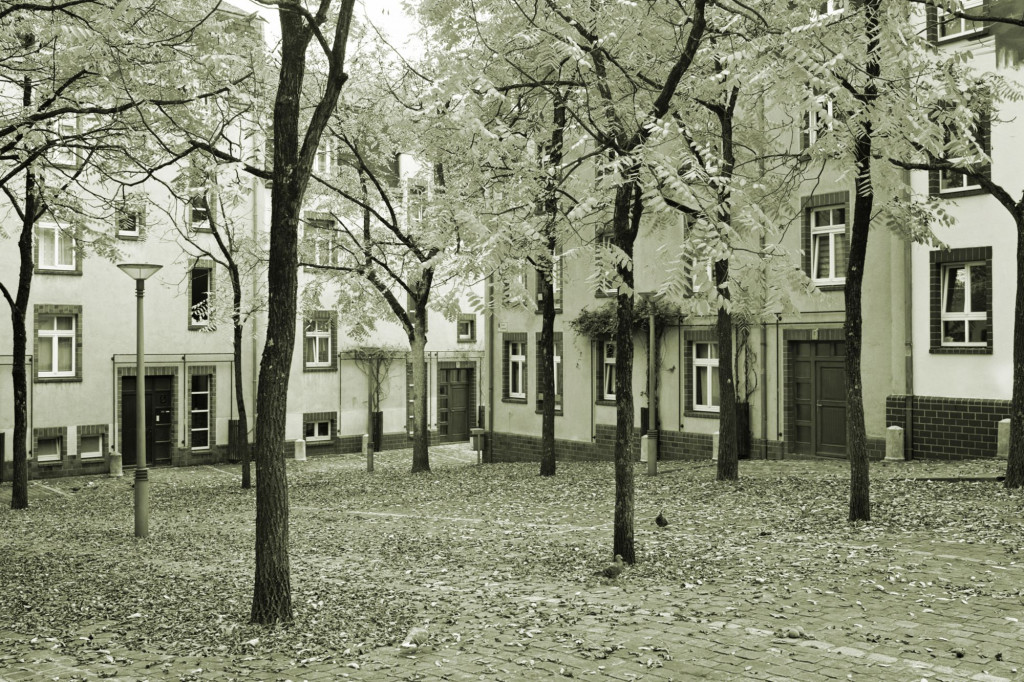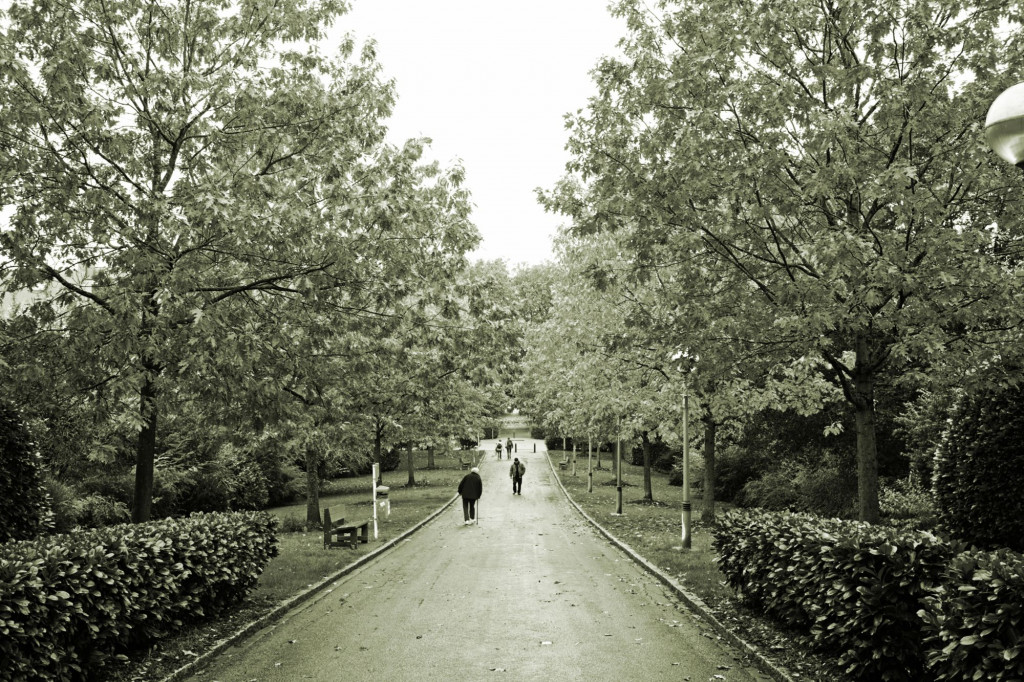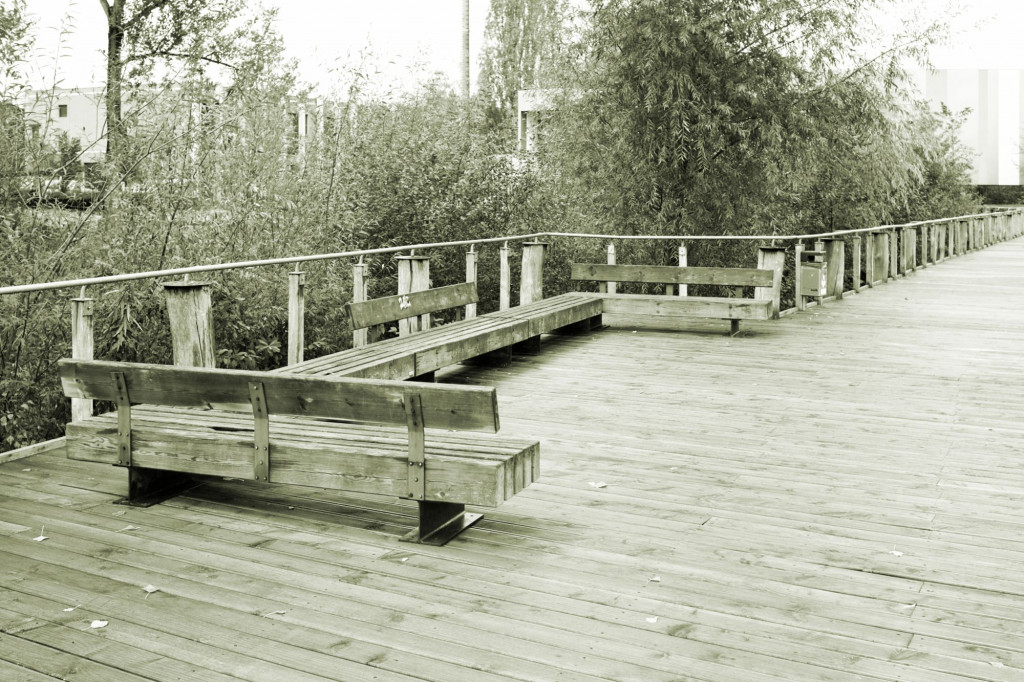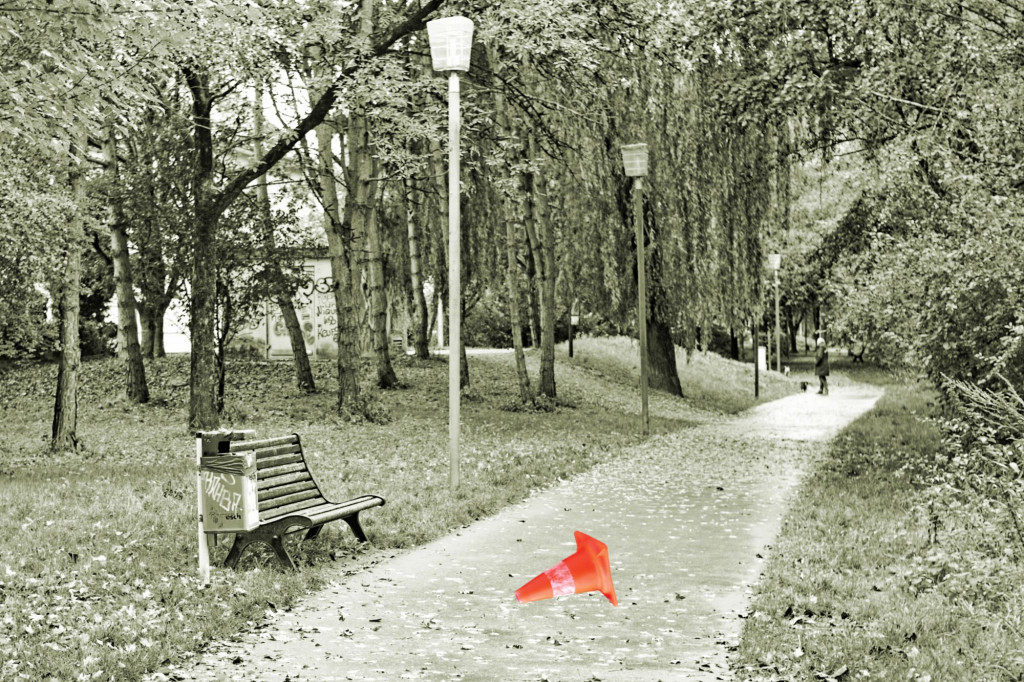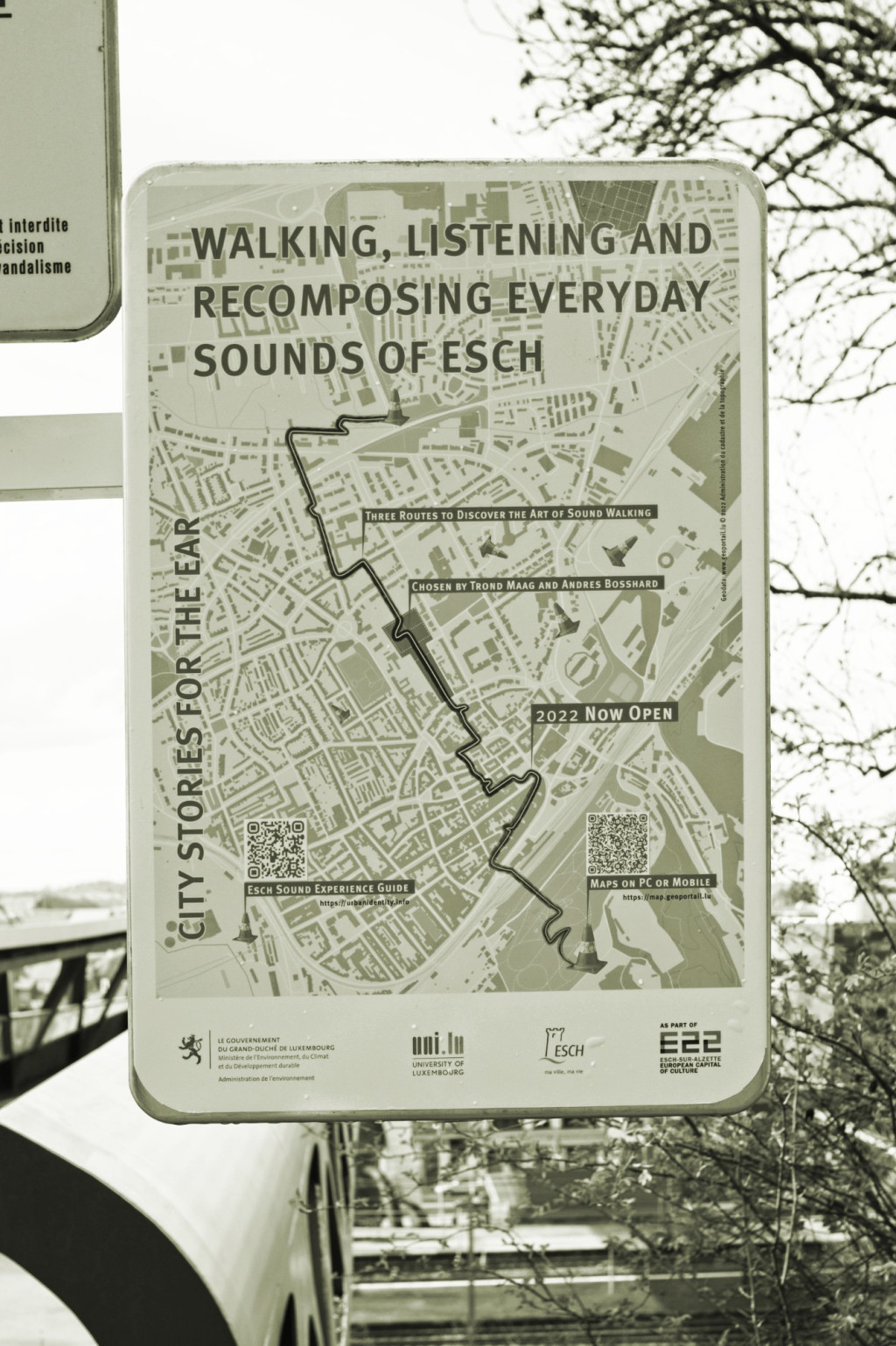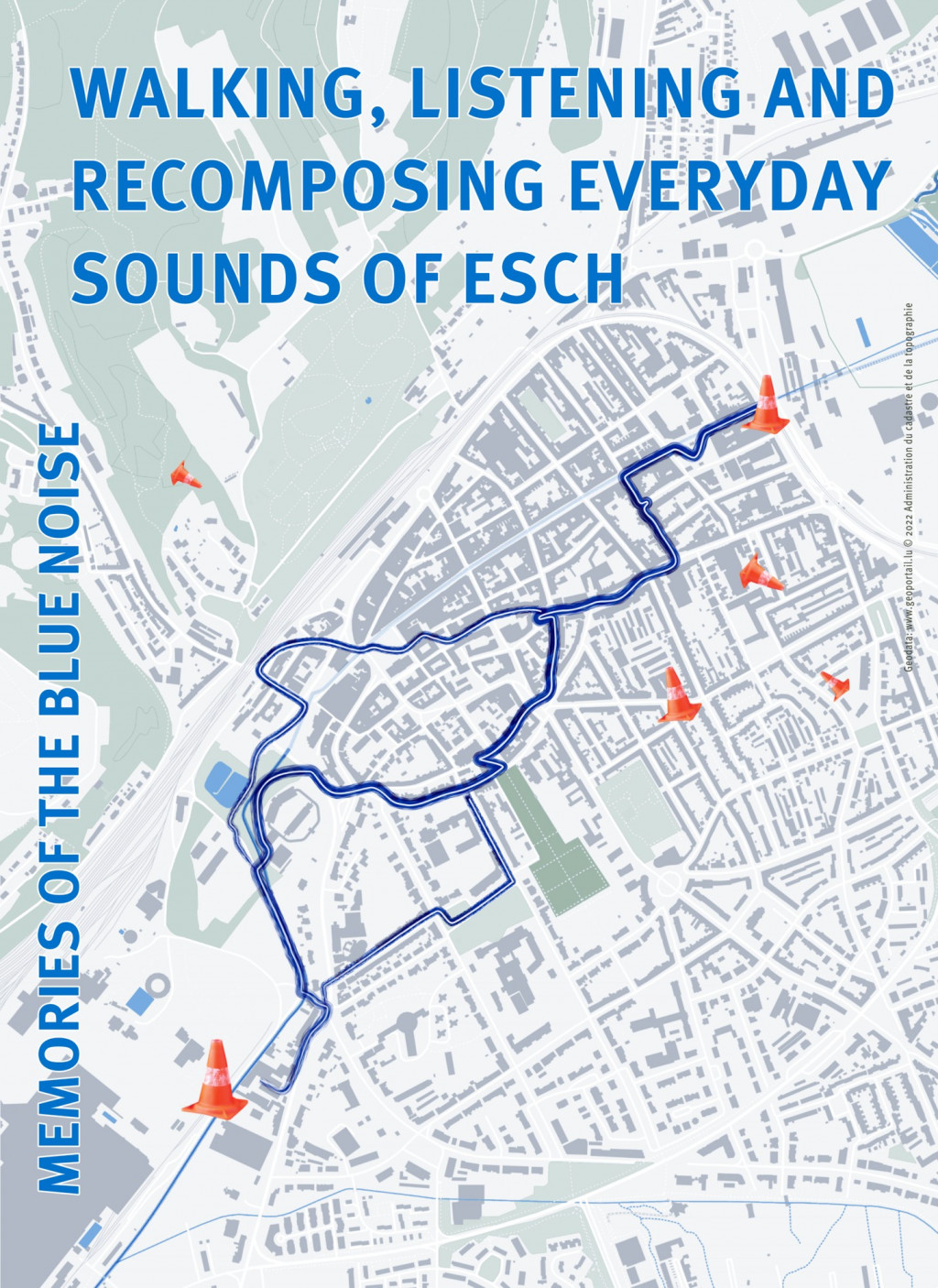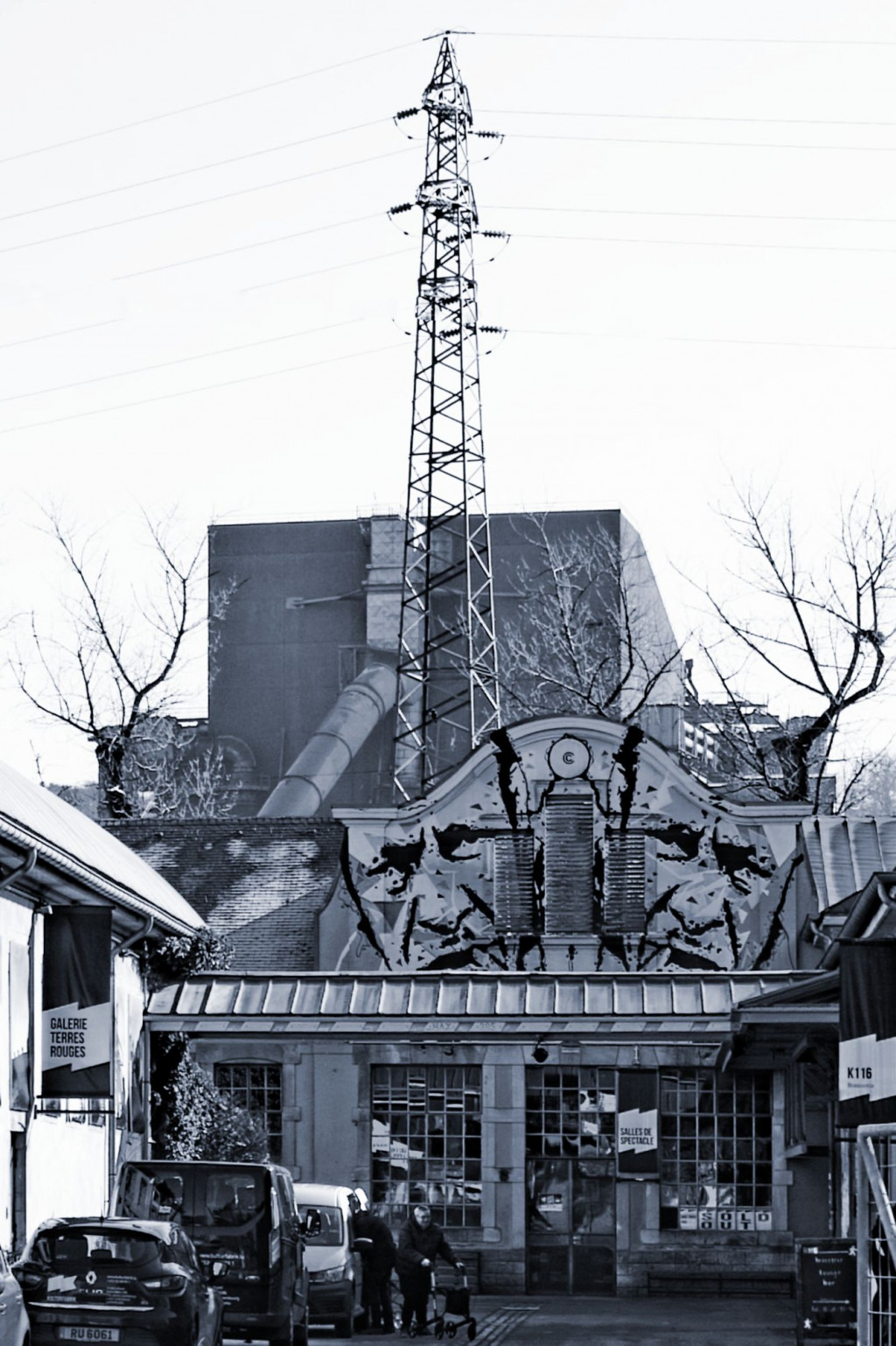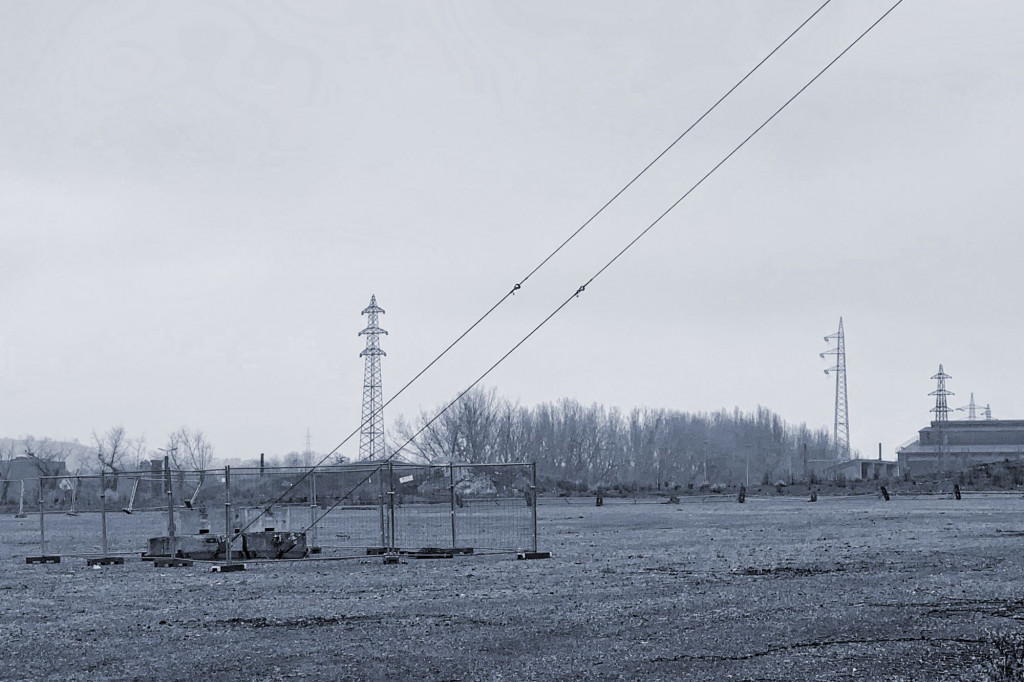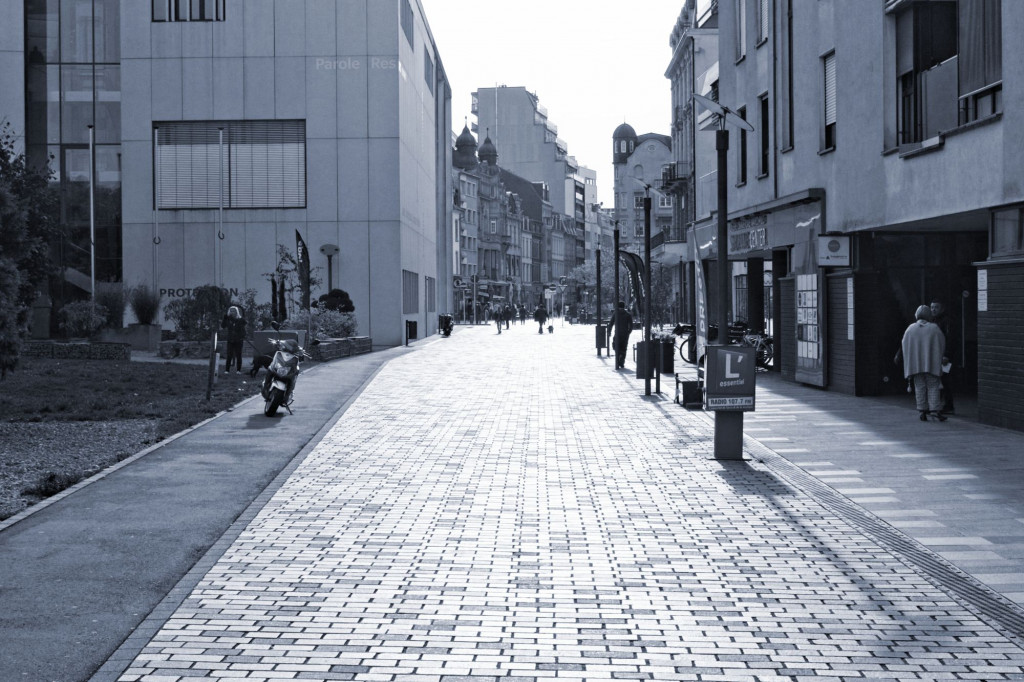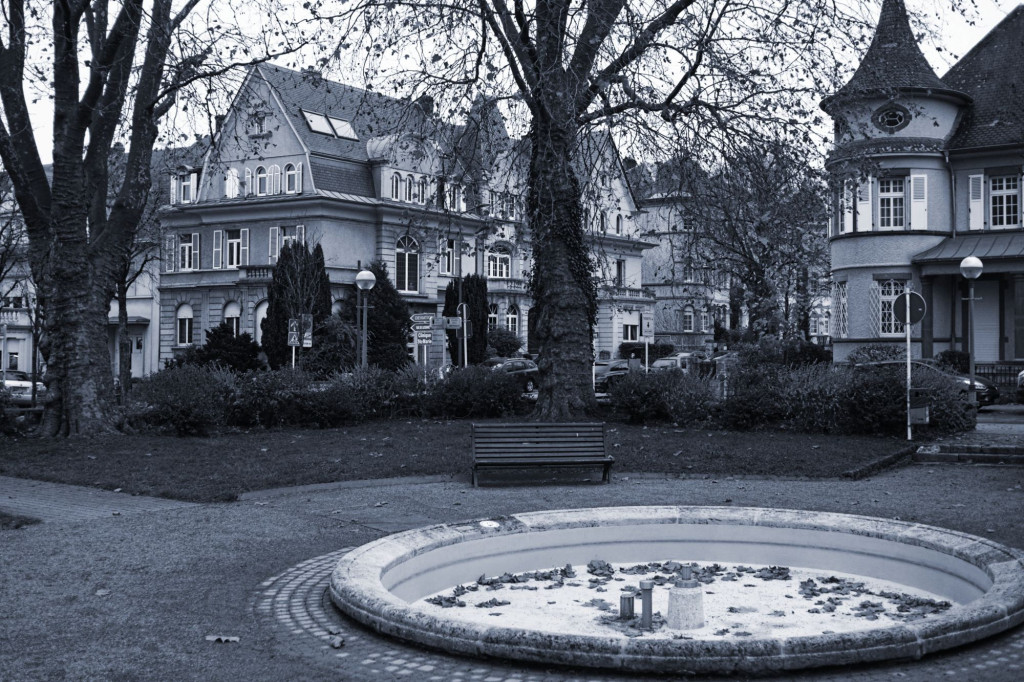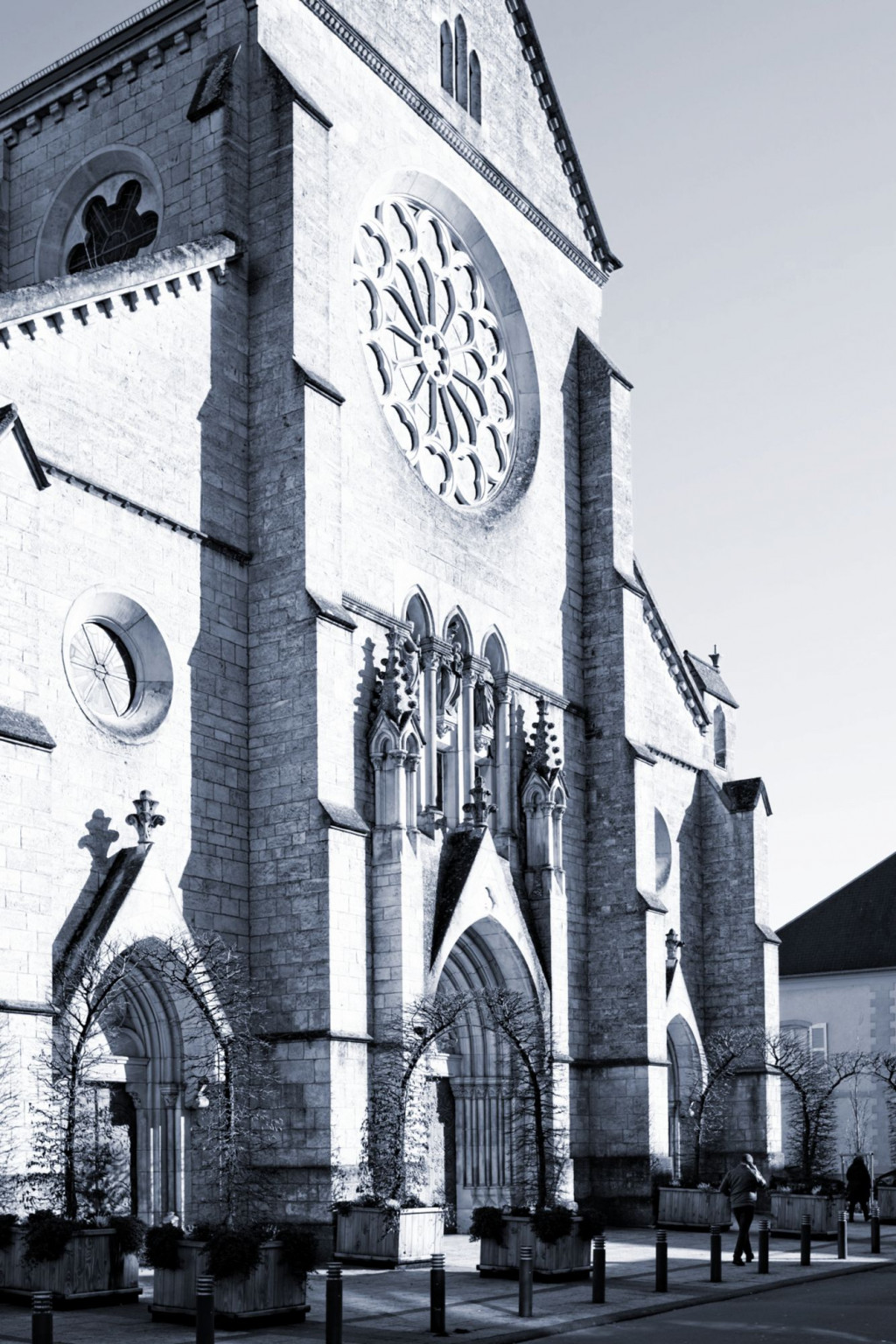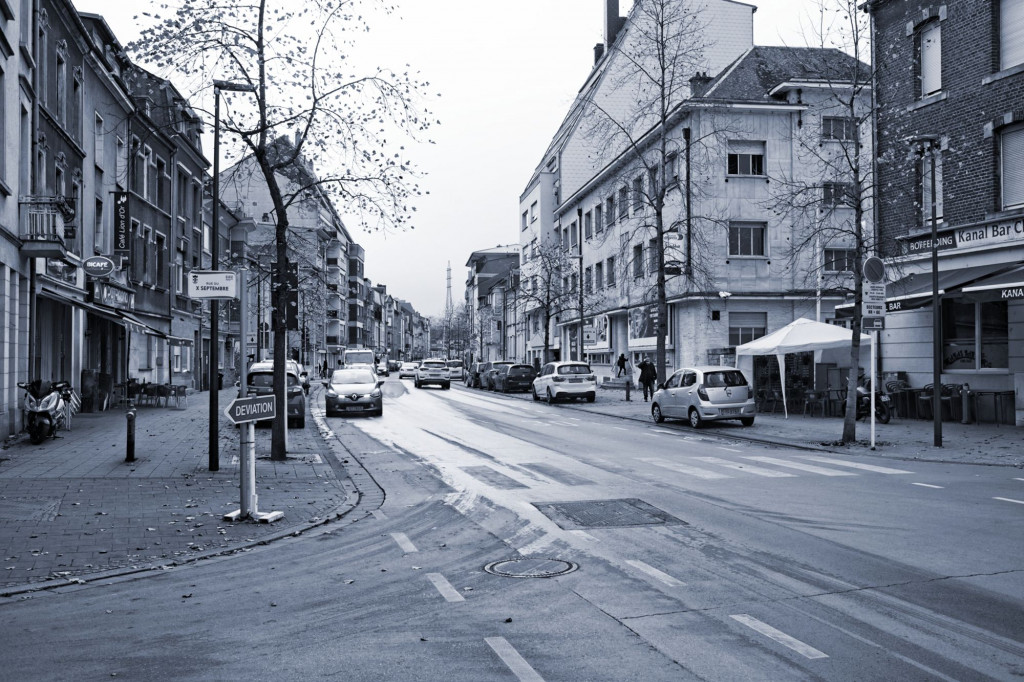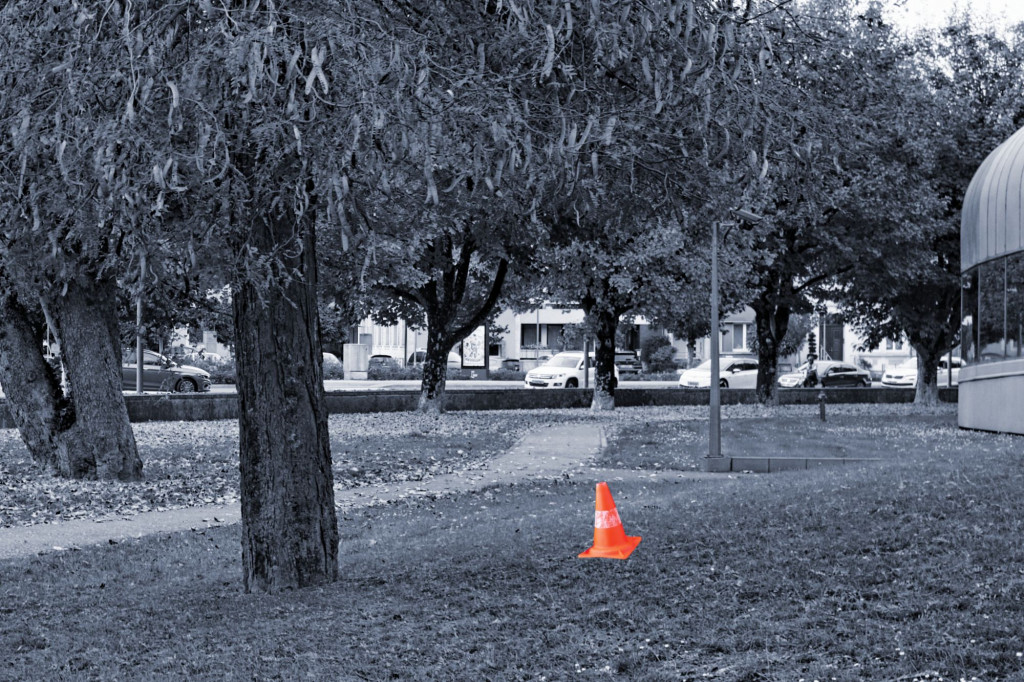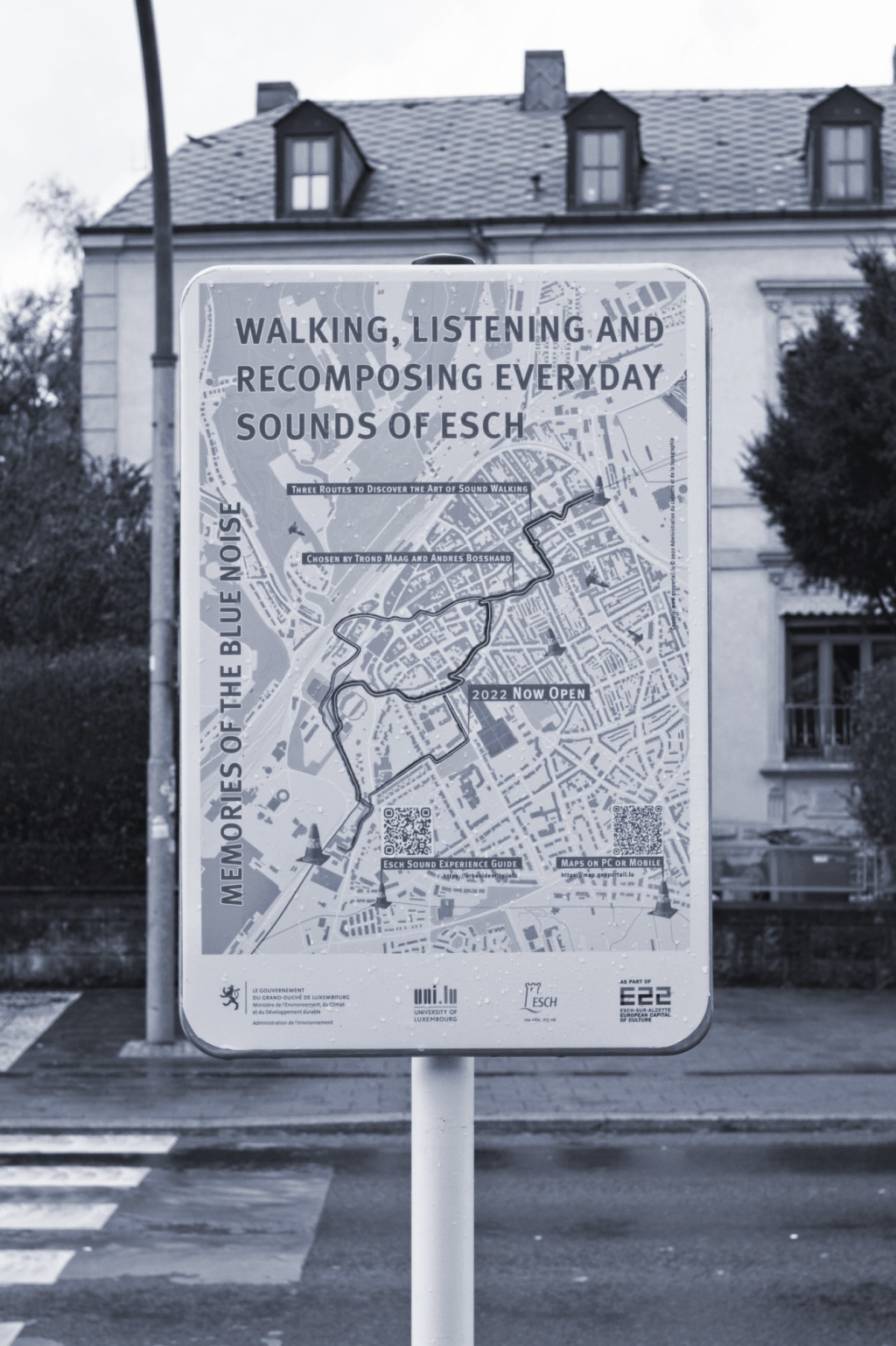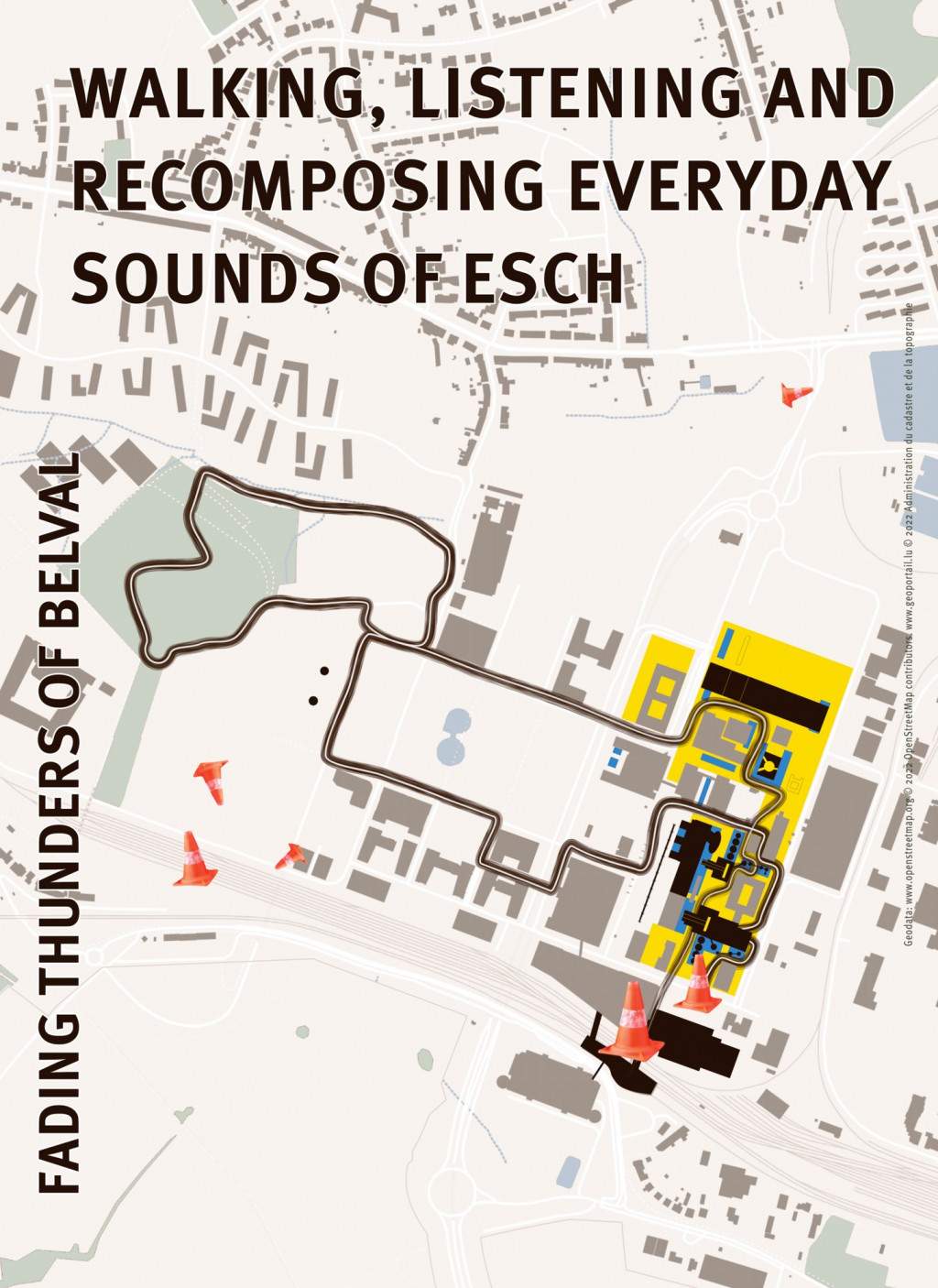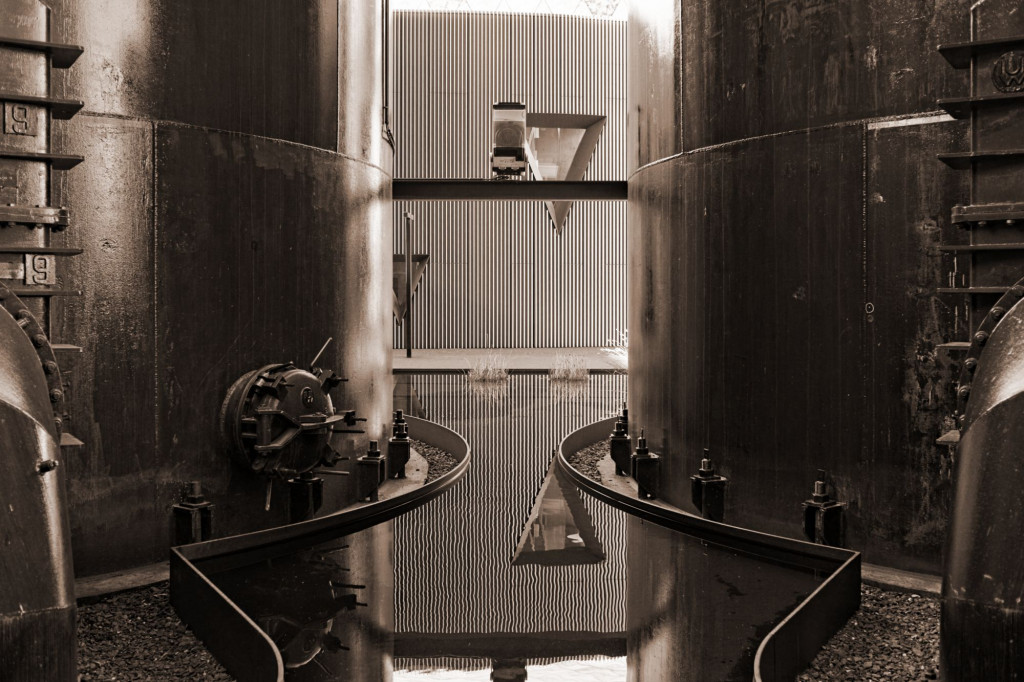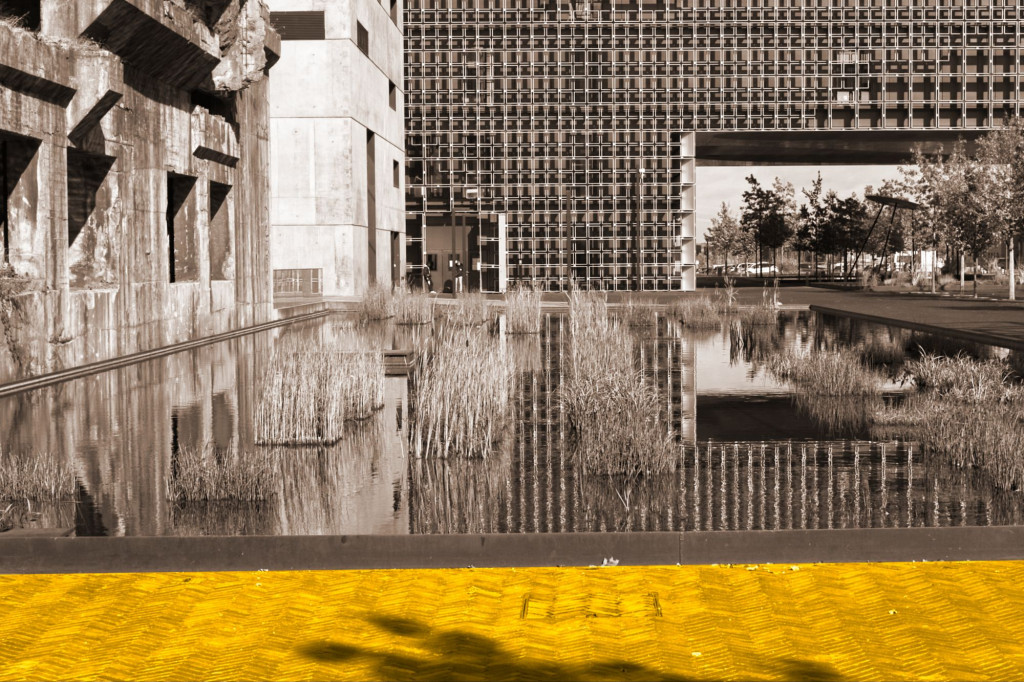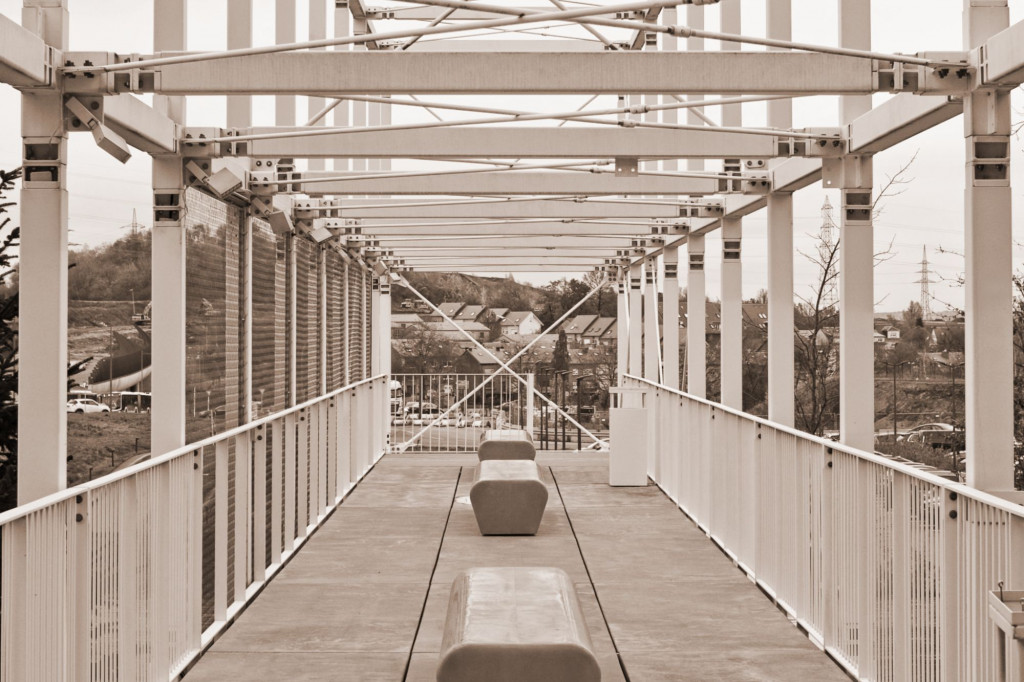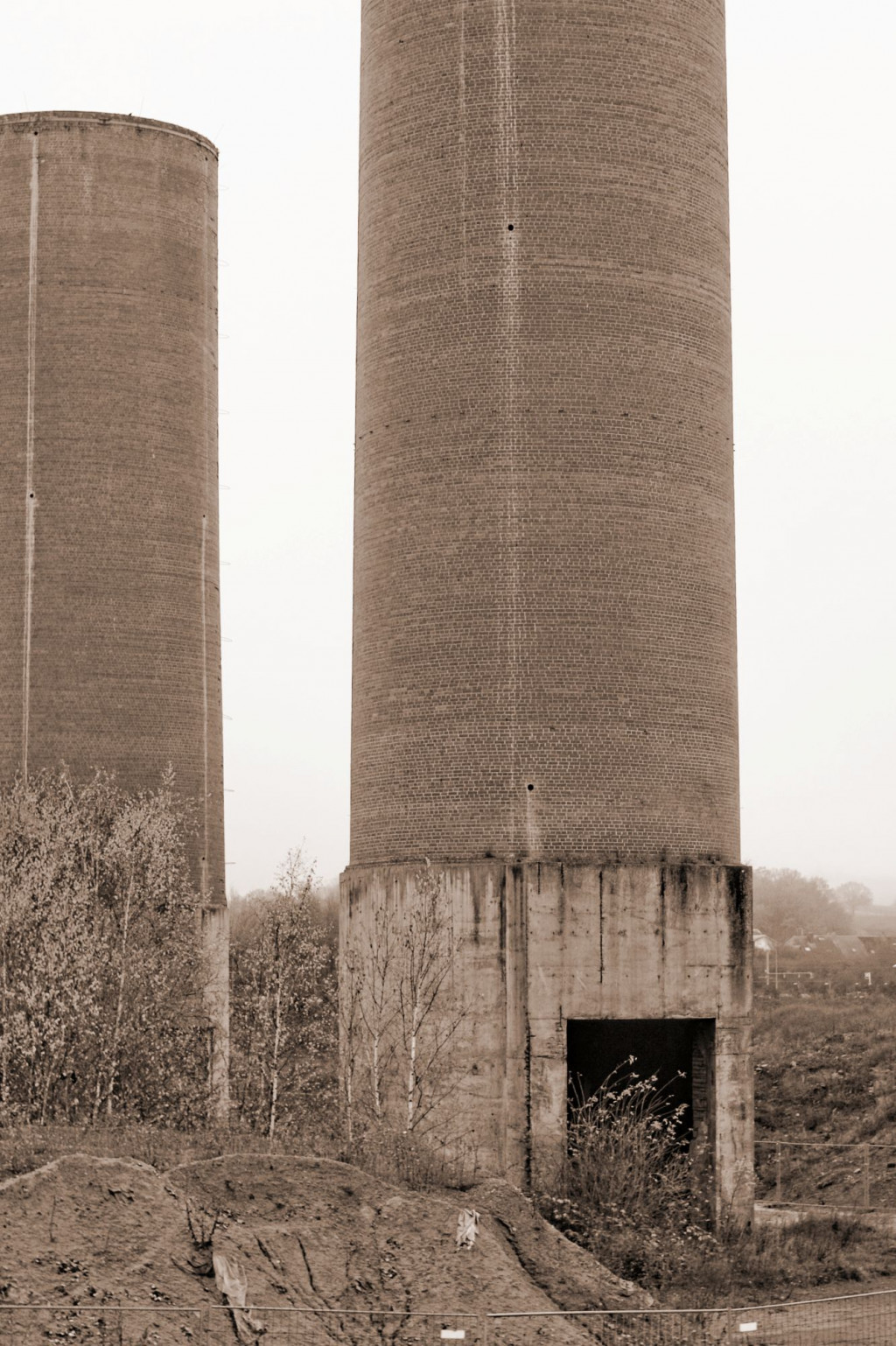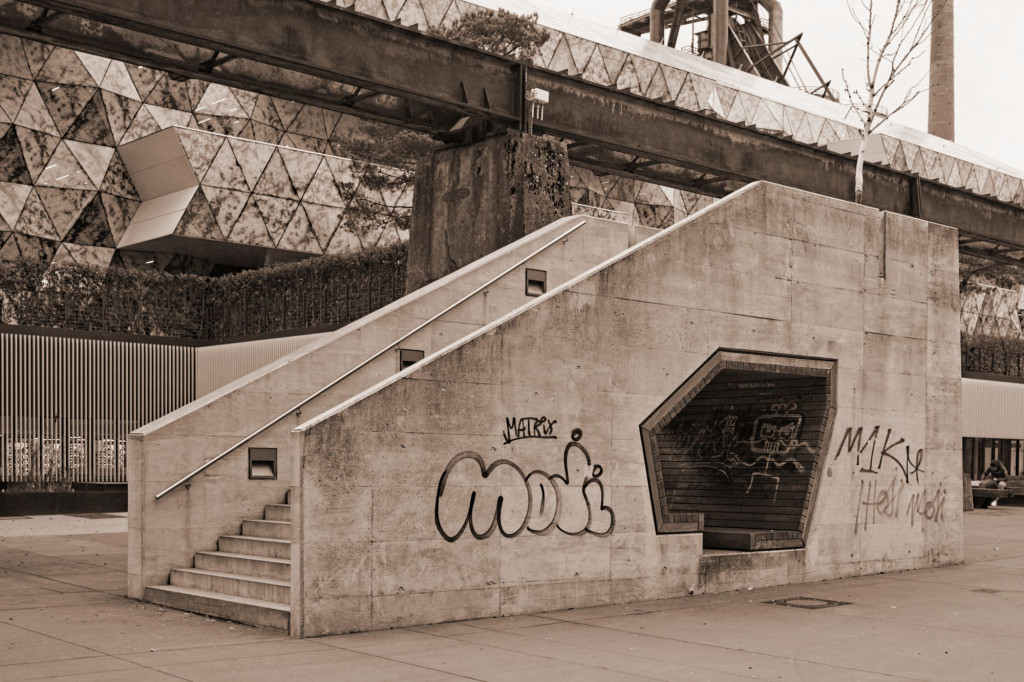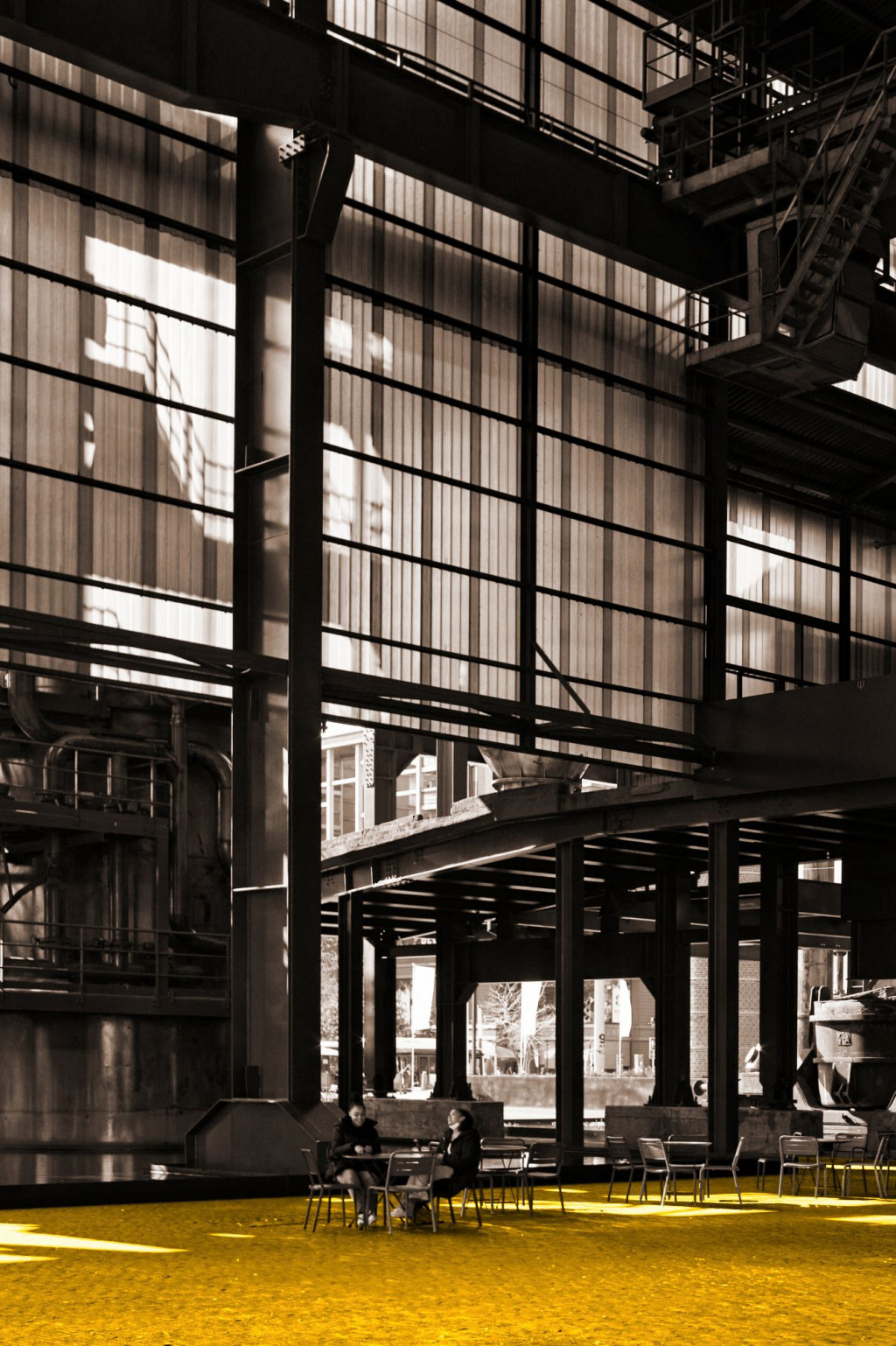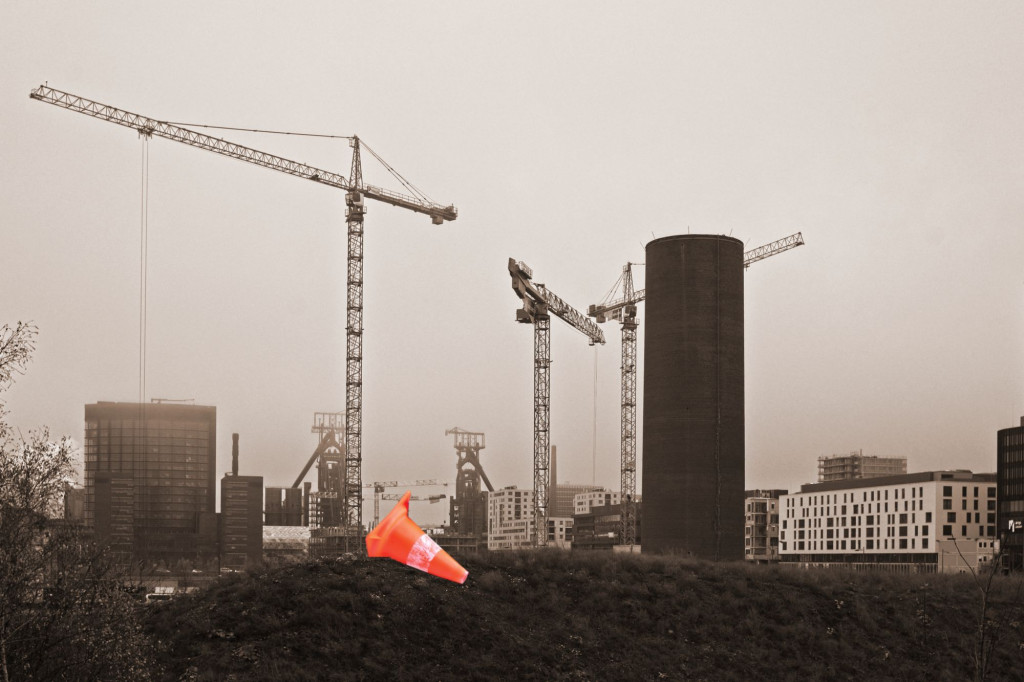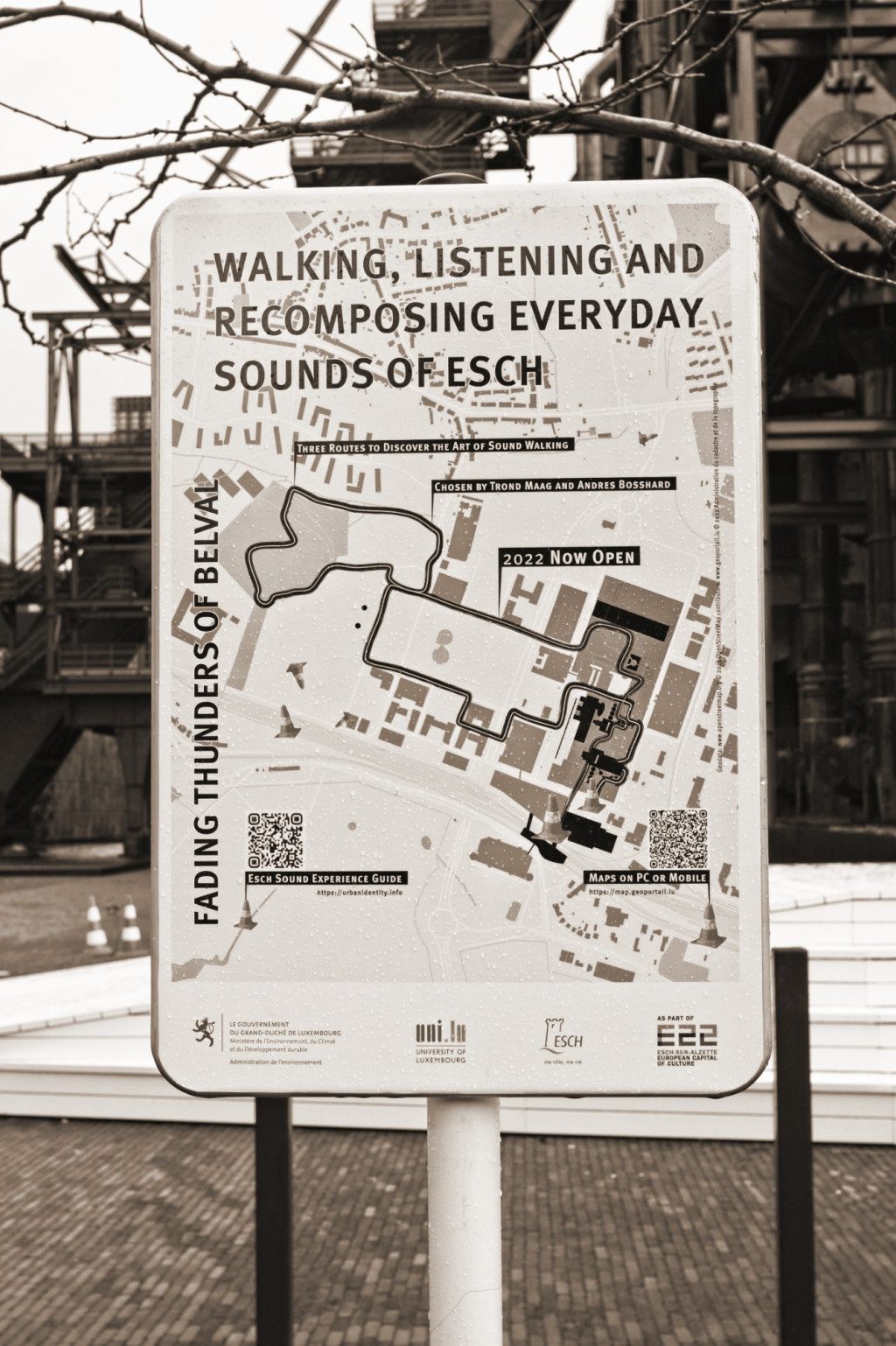
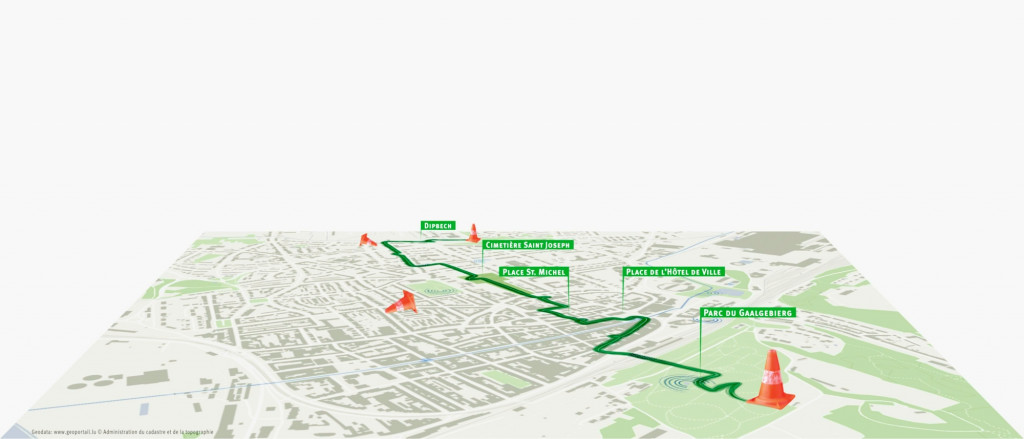
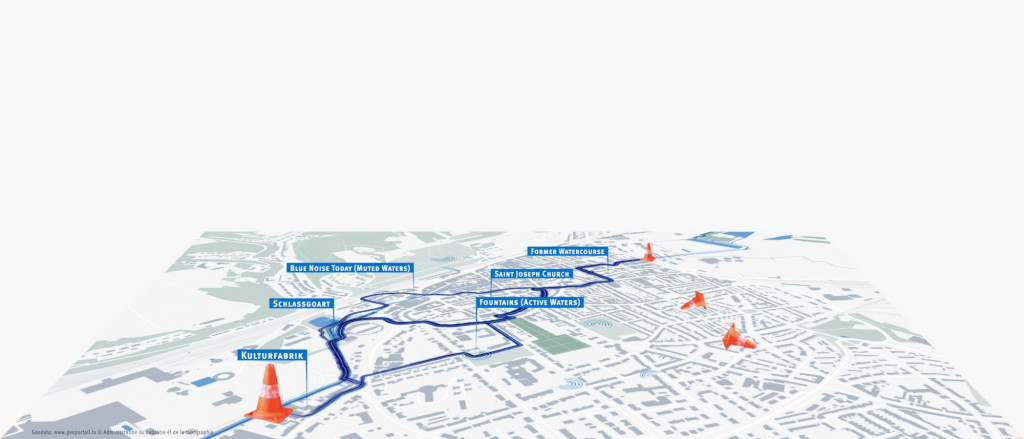
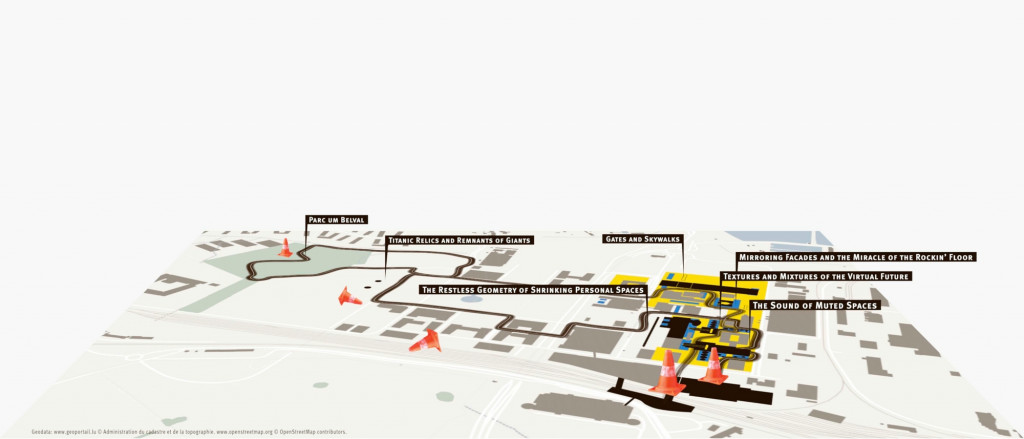
Take time to slow down and become aware through active listening. You will notice that every step reveals how sound propagates and accumulates in space, transforming how you perceive the city. Your ear places you in the centre of the environment, where you can comprehend the city coherently. You actively connect single sounds into a track of acoustic events that progresses according to your own poetic narrative.
Experiment with various reference points in squares, streets, and parks. Explore these locations to find surprising moments of silence! These moments allow you to calmly and gently connect with the spaces nearby, the neighbourhood, and the city. Share your observations and favourite sound reference points. How will the walk influence your perception of Esch, your professional practice, your daily city walks?
How can we take responsibility for the sound of our city? We teach ourselves how to listen to Esch’s buildings, squares and streets, how to talk to the city, and how the city talks to us. You can put this sound-aware knowledge into practice at home and explore ways of modifying your city’s sound while walking, shopping, and meeting people.
Walking, Listening and Recomposing Everyday Sounds of Esch looks at the acoustic environment’s quality as an essential factor for the city. However, sound is not always understood as a designed and planned quality within the urban design process. Sound can be shaped through the contributions and perspectives of individuals and local communities. Also, the acoustic argument is vital for creative approaches, architectural projects and spatial productions. It plays an essential role in individual well-being and public health: The various elements of the built, social and natural environment articulate and shape every possible sound, influencing how people acoustically experience the city and respond to the sounds they hear.
Walking, Listening and Recomposing Everyday Sounds of Esch draws the attention of residents and visitors of Esch to an active engagement concerning how surfaces, materials, architectures, landscapes, and how people activate these forms, contribute to the sound and identity of a city experiencing significant developments from its industrial-based history.
>> DOWNLOAD GUIDE (PDF) <<
The walk unearths the garden city’s acoustic legacy and introduces visitors to greening strategies. Visitors experience parks and gardens taking an essential role in counter-designing the industrial city’s denser block development. They discover how landscape and architectural elements can appeal to the ear and help draw the listening attention to the location.
Esch’s identity doesn’t only contain iconic references to its industrial history. Also, a natural landscape shaped and transformed by industrial and cultural achievements surrounds the city. As they gaze out and listen beyond Esch from the Gaalgebierg, visitors figure out the landscape’s terrain and receive a taste of what they expect in the city centre: The urban planner Joseph Stübben proposed a garden city in his «Stadtbauplan für Esch an der Alzette», providing that visitors today can experience the city as astonishingly green. Stübben’s city plan is almost a hundred years old and laid the essential principle for today’s pocket parks in the city centre, green belts along watercourses and new parks and gardens within the industrial sites.
In the industrial era, parks were the city’s green lungs and meeting points where people could relax after heavy workdays and thus of utmost importance. The garden city soon turned out to be the counter-design of the industrial city’s dense block development, bringing city dwellers closer to nature and improving their well-being. Like in up-and-coming Belval, the residents in today’s developments also have an essential need to live close to places for recreational purposes. Whether for relaxing, participating in social activities or playing sports, people prefer locations within walking and cycling distance and open to all. Exploring the walk’s various locations soon reveals which ones appeal better to the ear or are more fragile and sensitive to background noise and bothering noises in the foreground than others. Which public realm’s design is strong enough to set sounds pushing the noise into the background of perception?
>> DOWNLOAD GUIDE (PDF) <<
The walk is dedicated to Esch’s hidden rivers, following the broken and obscured noises and sounds of the river water through the city. The blue noise disappeared a long time ago from the everyday city but still hovers between the buildings, which reverberate the stream of people’s sounds and voices. Knowledge of the blue noise could direct the city’s development.
Both the city of Esch and its main shopping promenade have the river Alzette in their names. However, we can neither see nor hear the river today in the city centre, through which the river Alzette has flowed underground since the beginning of the 20th century. Only a few locations refer to the river and bring acoustic memories to today’s reality. Also, access to the river is not always easy outside of the core city because it flows underground through channels or over brownfield land – the Terre Rouges – usually not accessible. The city structure reveals historical watercourses and moats, which later urban planning steps have covered with roads.
The names of streets and squares, old buildings, and industrial relics hark back to when the residents used the river water for commercial and functional purposes. However, it doesn’t have a particular meaning for today’s purposes so far. The river mostly remains without any public access and without being visible nor audible.
Existing urban spaces and particularly former industrial sites near the city centre will experience further conversion into new purposes to serve the public needs for relaxation, cultural activities and housing. With this in mind, Esch’s collective memory for its water sounds could actively direct and modulate urban development steps. Discovering and exploring the blue noise thoroughly to support these steps moving forward possess inspiring potential.
>> DOWNLOAD GUIDE (PDF) <<
Visitors can immerse themselves in a former industrial environment currently radically changing and witness new ideas and spaces developing. The dynamic madness of the metallurgical age has faded. The immense dimensions of steel structures contrast with expansive brick walls, monstrous cranes, and labyrinths of giant pipes that shape today’s everyday sounds.
Two modes of existence hover in this realm, unable to give peace to today’s reality: Almost inaudible echoes of thunder, heavy metal percussion and beats, and the fading of earthquake-like unrest still reach the innermost parts of our bodies. Now they are silenced but smouldering with vibrations of a ghostly afterlife. No, these giants in Belval will not rise again, but the titanic relics remain and will continue to overwhelm us, humans, for a long time.
Surprisingly, the panorama of history is interrupted by metamorphic architectural modules of the emerging post-industrial era. While we can witness how new parks, event venues, car parks, workplaces, and housing evolve, we can understand how radically this environment is currently changing, and the sites of former steelworks and production buildings are being transformed. New possible routes through the acoustic terra incognita offer a still unknown audible variety of spaces, materials, shapes and dimensions.
No one knows yet whether the new voices of dark, still water mirrors and perfect glass cubes will be strong enough to clear the post/industrial reverberation of the permanent traffic patterns on land and in the air.
Chosen by urbanist Trond Maag and sound architect Andres Bosshard
Commissioned by Administration de l’environnement Luxembourg
With contributions from Département de Géographie et Aménagement du Territoire / Université du Luxembourg, Sound of Data workgroup / Université du Luxembourg, and Service écologique / Ville d’Esch-sur-Alzette
As part of European Capital of Culture Esch2022

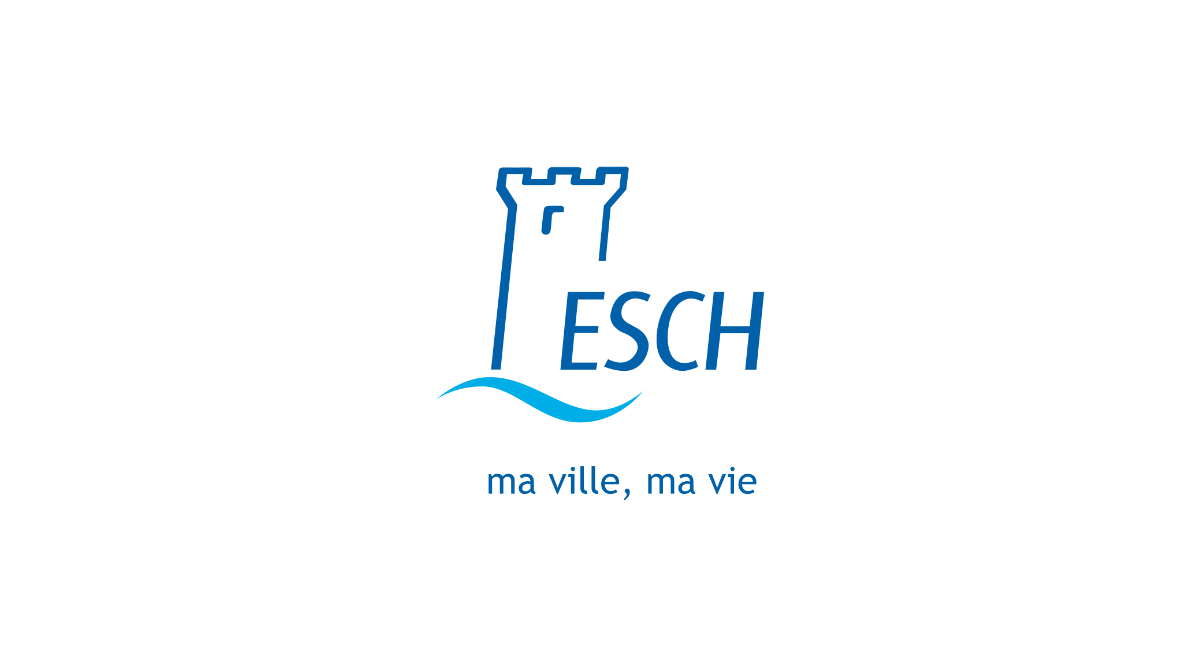


Contact: soundexperienceesch (at) urbanidentity.info
Hashtags: #Esch2022 #EuropeanCapitalofCulture #ExperienceEsch2022 #remixculture
© urbanidentity Zurich except unless stated otherwise
Geodata: www.geoportail.lu © 2022 Administration du cadastre et de la topographie. www.openstreetmap.org © 2022 OpenStreetMap contributors.
Trond Maag, urbanist, and Andres Bosshard, sound gardener, provide a working practice that involves listening combined with walks within urban design processes.
They are involved in developing sound-aware cities and tools for the knowledge transfer of urban sound between planners, architects and urban designers.
Walking, Listening and Recomposing Everyday Sounds of Esch will be developed, modified and adapted continuously
